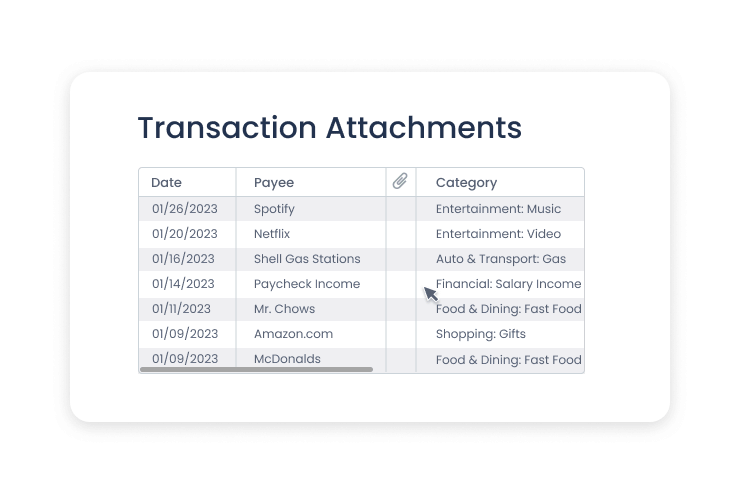6 Great Ways to Use Transaction Attachments
Keeping your financial documents organized is vital to good financial tracking. Documents serve as proof of income and expenses, proof of purchase, proof of contractual obligations, and more.
Many financial documents are useful for tax purposes or when applying for loans and other financial products. Additionally, financial records can be helpful in warranty claims, audits, or disputes over financial matters. That’s why Quicken provides a convenient way to attach your financial documents to their underlying transactions, making them easy to find and access when you need them.
In fact, Quicken lets you attach as many documents to a single transaction as you need. All your attachments will be available on the primary computer where you use Quicken, and your most recent three attachments for any given transaction will also be available via the cloud, where you can access them from the mobile app or via the web.
Ready to take your attachments to the next level? Here are six great ways to use them.
Receipts
When most people consider attaching a document to a transaction, they think about receipts, and with good reason. Attaching a receipt can help you track splits (purchases with multiple categories), and it’s great to have that copy handy in case of returns. It’s also helpful to have some receipts for tax purposes, especially transactions involving donations or business expenses.
Warranties
For purchases such as furniture, appliances, and electronics, your warranty documents are vital if something goes wrong. While it’s great to have paper records of your warranties, more and more of these documents are being provided electronically. Attaching those files to your transaction record can save you a lot of headaches.
Even if your warranty records are printed, you can always scan or photograph those records to save them in Quicken. Attaching them to the underlying transaction also makes those documents extremely easy to find. Just search Quicken for the purchase, and your warranty information (not to mention that receipt) will be right there with it.
Service contracts
Much like warranties, service agreements are important documents that can easily be coupled with the transaction you made to purchase the agreement. That way, if you experience problems with a product, you know where to look for the paperwork to get that product fixed.
Photos
One of the lesser-known uses for transaction attachments is product photos. Product ID numbers, phone numbers, instructions, and other key information often appear on products or their packaging. Getting that data recorded can come in handy, especially if you don’t want to keep the original boxes. Do you have loss protection for that new watch? Snap a photo of the serial number and save it in Quicken!
Checks
When a purchase or sales transaction involves a check, you might want to keep a picture of that check for future reference. This is especially handy in the case of a payment dispute. Banks often place limits on the amount of time they’ll store a check image — Quicken’s attachments don’t have an expiration date.
Titles and other sales documents
Some sales transactions, such as vehicles and real estate, come with titles, liens, contracts, and other documentation. Capture this information in Quicken by adding these documents to sales transactions as attachments.
Remember to keep a backup
While attaching files to your transactions is not required for the effective use of Quicken, it does provide an excellent way of putting all your financial documentation in a single searchable location. Have you set up your online backups? Your Quicken subscription includes free access to a Dropbox account — claim your account now to back up your Quicken file in a location other than your computer.
Quicken has made the material on this blog available for informational purposes only. Use of this website constitutes agreement to our Terms of Use and Privacy Policy. Quicken does not offer advisory or brokerage services, does not recommend the purchase or sale of any particular securities or other investments, and does not offer tax advice. For any such advice, please consult a professional.
About the Author
John Hewitt
John Hewitt is a Content Strategist for Quicken. He has many years of experience writing about personal finance and payment processing. In his spare time, he writes stories and poetry.



